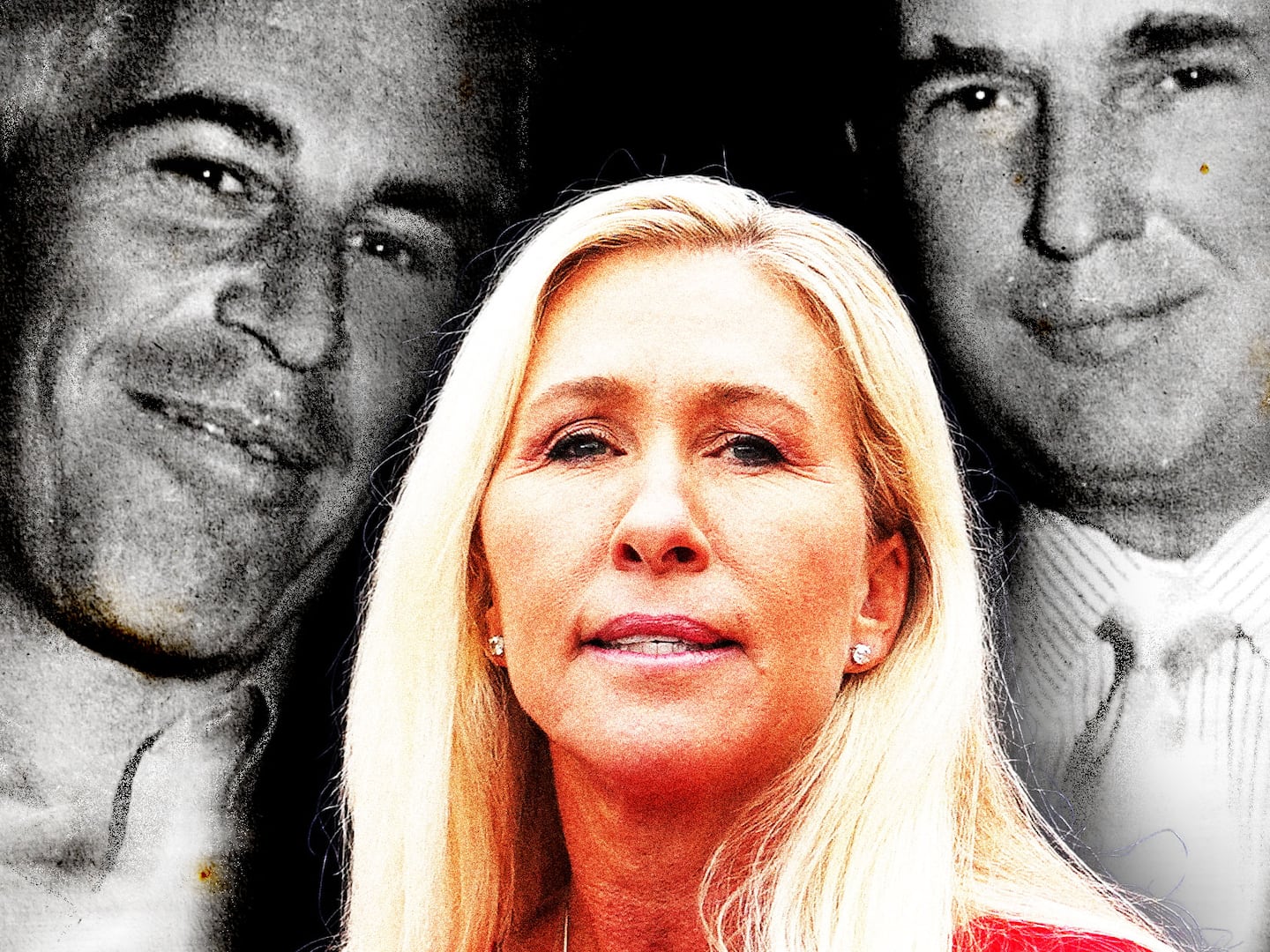Over a million dollars worth of paintings, sculptures, and artistic ephemera vanished from The Colony Room, an elite counter-culture private drinking club, according to a writer and artist whose new book chronicles the history of the legendary London venue.
Darren Coffield, who has a new exhibition about The Colony Room opening at the Dellasposa gallery in London this week, tells the amazing story of the missing art works in his new oral history of the club, Tales from The Colony Room.
He told The Daily Beast that, while interviewing dozens of England’s most celebrated artists to gather their recollections of the club, the question he was most often asked was whether he knew what had happened to work they had casually hung on the club’s walls, or sketched on napkins to cover bar bills.
Among the missing pieces is an early spot painting by Damien Hirst that would alone be worth almost half a million dollars. Given how many other drawings, sculptures and photographs adorned the club walls, it is estimated by sources that the total value of the missing haul could be in the range of £500,000 - £1m ($650,000 - $1.3 million).
The works are believed to have been swept up under cover of darkness in a covert operation by the man who ran the club at the time, Michael Wojas, after it closed its doors in the winter of 2008. Many of the artists believed their work would be auctioned to help “save” the club but, Coffield says, neither “hide nor hair” of any of it has been since.
Wojas, who had become addicted to crack cocaine, died of cancer in 2010 and never revealed the final location of the works.

Sarah Lucas and Damien Hirst party at The Colony Room
Pascal Latra / Tales From The Colony RoomIt was an appropriately controversial end to The Colony Room, a byword for raucous daytime drinking among London’s dissolute bohemian set. The club opened before lunch and closed by 10 p.m. (at which point, at least after 1985, its denizens often decamped to the Groucho Club next door). The unusual hours of the private clubs were a legacy of British licensing laws, which prohibited public houses, aka pubs, from opening before 6 p.m. Private clubs filled the gap for thirsty afternoon drinkers.
Painted a distinctive emerald green color, the club was located in one comparatively small room on the first floor of a Georgian townhouse in London’s Soho district.
“The entire room was only seven or eight meters (23-26 feet) long, including the bar, it was absolutely tiny. So if you were drinking in the club and someone was having a fight or having an argument, everyone would get involved in it,” said Coffield, who was a regular at the club from the late '80s.
It was, in its early days, a haven not just for artists but also for many of London’s marginalized communities; The Colony Room was one of the few places in the U.K. where transgender people and inter-racial couples were welcomed in the '50s and '60s. The club’s founder, Muriel Belcher, who greeted her members with a cheery, “Hello Cunty,” upon their arrival, was a lesbian whose girlfriend was from Jamaica, thus lending a knowing irony to the apparently Imperialist name.
Belcher didn’t model the club on Gertrude Stein’s legendary Paris salon, but the two were often compared. Both specialized in gathering together an unlikely collection of amusing and inspiring guests. Unusually for mid-century London, the club also facilitated mixing between the classes.

Michael Wojas cleaning the club
Amelia Troubridge / Tales From The Colony Room“The clubs today are very different, they’re very exclusive, and they are all about having money. At the Colony Room, it was about being witty and being able to entertain people,” says Coffield, “The worst crime was to be a bore.”
Stein’s salon became synonymous with Picasso and Matisse while Belcher’s Colony Room had Francis Bacon and Lucian Freud. Frank Auerbach, John Deakin, and Michael Andrews were other regulars.
Bacon’s generation had stopped using it regularly by the time Belcher died in 1979, but the club was rediscovered by a hell-raising cohort of younger artists in the '90s, collectively known as the YBAs, short for “Young British Artists.”
Chief among the Colony Room’s new fans was Damien Hirst, who is widely rumored in the art world to have pumped considerable funds into the club to help keep it going.
Hirst, like many of the artists who drank there, occasionally hung pieces on the wall, including one early spot painting which would now be worth around $500,000. The custom harked back to a tradition of hard-up members sketching works of art in settlement of overdue bar bills.
The artist Gavin Turk, for example, signed a piece of pink foam for the barman after being told he did not “take plastic.” Turk also hung another piece on the walls, an edition of one of his best-known works, a blue plaque bearing the words “Gavin Turk Sculptor Worked Here.” Both are among the items to have vanished when the club was abruptly closed down in 2008 by its then proprietor, Michael Wojas.
The ownership of the club was complicated and opaque. Wojas had been the barman at the club for decades and “inherited” it from Ian Board, another barman who had himself inherited it from Belcher in similar circumstances. The actual “ownership” of the club and its assets was much disputed.
Wojas, who took over the club in 1994, ultimately fell out with many of the members, but was much loved in the earlier years of his reign.
The gallerist Detmar Blow, for example told The Daily Beast that he always appreciated and liked seeing Wojas when he called into the “civilized” Colony Room for an early afternoon drink.
Wojas presided over the renaissance of the club as a haven for a new generation of artists, with some of the leading names in British art, including Hirst, Tracey Emin, and Sarah Lucas becoming regulars. He persuaded members and their friends to work as guest bar staff, meaning anyone from Kate Moss to Sam Taylor-Wood could be found serving drinks.

Writer Frank Norman outside the Colony Room in London’s Soho
Daniel Farson / Tales from The Colony RoomHowever, things unraveled as Wojas’ drug addiction spiraled. Coffield says, “Michael unfortunately developed a very bad crack cocaine addiction. The habit was very, very expensive, and although the club was viable, it wasn’t viable enough to pay for a £500 a day crack cocaine habit, so he started selling off the clubs assets under the auspices that the club’s lease was up for renewal, and the club would have to move.”
“He eventually organized an auction to try and sell off the rest of the paintings, but a bunch of the members got together and got an injunction to stop him doing that.”
On 15 December 2008, Michael threw a 60th anniversary party for the club, before declaring it closed. Two days after Christmas, Coffield says, “He went in with some friends and a few vans and stripped the entire premises down, including all the artworks and even the carpet.”
Coffield heard on the grapevine that the entire collection was offered to leading British art gallery The Tate in its entirety about five years ago, but the deal went nowhere.
“The most frequent question I was asked while writing this book was, ‘Whatever happened to my artwork?’ Sometimes it was the children of the artist asking that question. For all we know, it could be in a lock up somewhere, rotting. No one knows. It’s an enigma.”
Coffield, an award-winning artist himself, took his own work down from the club’s walls six months before the end, suspecting Wojas was selling off work and pocketing the proceeds.
“In a way I have a sneaking admiration for him, because he was always one step ahead of everyone else,” Coffield says. “It was like the great train robbery or Dick Turpin. And it is hard to imagine that the club would really have survived these days. It was a place where people went to be naughty, it was a kindergarten for delinquents and with the advent of mobile phone technology, and people filming each other, I can’t really see how it would’ve continued to exist.”







